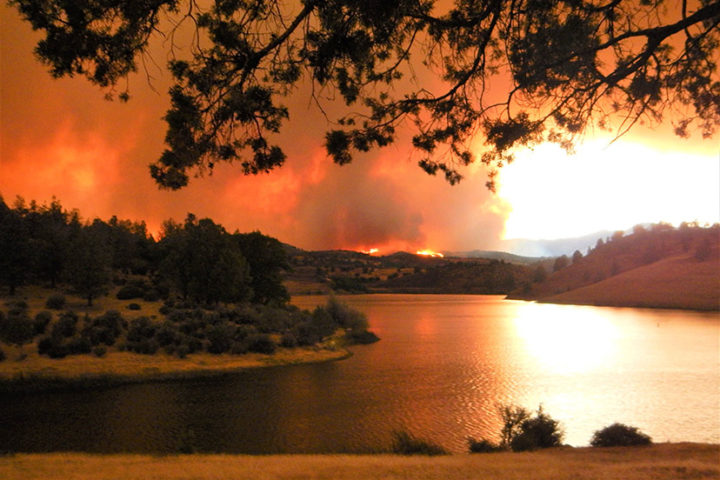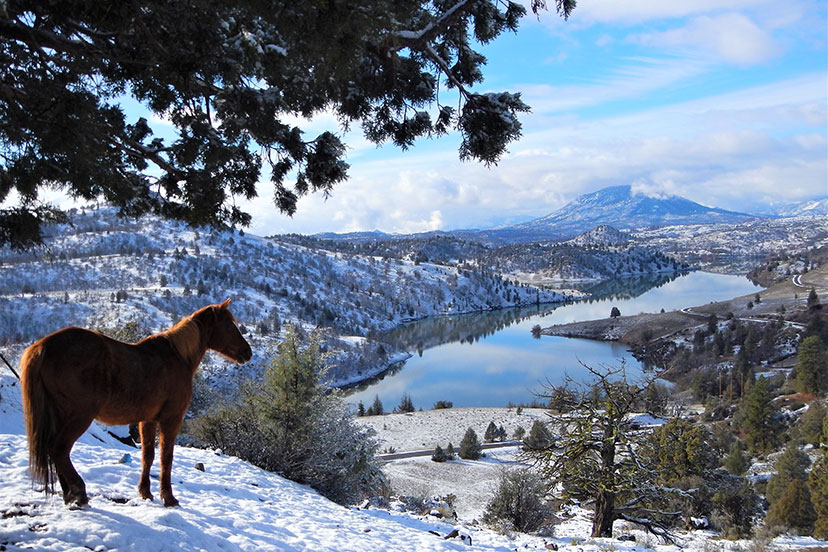It’s a plain fact that the size, intensity and frequency of catastrophic wildfires over the past decade are increasing.
And that is occurring even with Senate Bill 762 and comprehensive legislation passed with bipartisan support that provided more than $220 million to help Oregon modernize and improve wildfire preparedness through three key strategies: creating fire-adapted communities, developing safe and effective response, and increasing the resiliency of Oregon’s landscapes.
So How’s That Working?
Not so good, as we could all clearly see… if our skies weren’t choked with heavy toxic wildfire smoke.

And that’s because the core-root of the problem hasn’t been addressed in any manner — the collapsed herbivory; loss of 500,000 deer, elk and wild horse populations in Oregon that had previously maintained and abated over 2-million tons of annual grass and brush in Oregon, and loss of 2.5-million deer, elk and wild horses in California that had been maintaining 3-million tons of annual grass and brush, the key wildfire fuels.
Public forests and wildlife habitat in western states may soon be lost forever due to monetary driven management that ignores settled-science.
Wildfire management and firefighting have become a burgeoning multi-billion dollar annual business at the expense of American lives, homes, health, and our remaining designated and critical wilderness areas.
Some people and agencies, who may be monetizing catastrophic wildfire directly or indirectly may argue that I am over-simplifying a complicated problem.
However, those people (and agencies) are proven wrong by a preponderance of well-established science that is being ignored, and that points to the genesis of catastrophic as being the collapse of the native herbivory across the the western landscape leading to abnormal, prodigious wildfire fuels; namely the grass and brush that were previously well-managed by native large-bodied herbivores.
To such people, I would argue back that the subject of wildfire ecology and wildfire prevention and management has been made complicated by politics, obsolete administrative law, and monetary motivated administrative policies.
Money, politics and egos are what are complicating the simple, readily observable problem and the clear solution.
Before we breakdown and unpack the current failure in wildfire management (virtually no effective prevention), reasons and costs, we need a basic understanding of some scientific fundamentals that apply across much of the wilderness landscape where many of the catastrophic level wildfires evolve and subsequently spread to rural and urban cities and towns.
Recently, among many examples are the McKinney Fire (Siskiyou County, CA) and the Rum Creek Fire (Josephine County, OR) which began in deep wilderness where livestock fire-grazing is economically and ecologically prohibitive, but where wildlife, including wild horses can be intelligently and cost-effectively used for grass and brush reductions and year-round maintenance.
As we have seen in many past wildfires, and now again in the recent McKinney Fire that incinerated over 60,000 acres in Siskiyou County, CA, killing at least four people and destroying over 100 homes, many wildfires start in very remote wilderness areas that are laden with grass and brush fuels.
An herbivore is any animal that predominantly feeds on plants and grasses. This is important because multiple published scientific studies prove that; proper population densities of large-bodied herbivores reduce both the frequency and intensity of wildfires.
Excerpt from SCIENCE ADVANCES:
By altering the quantity and distribution of fuel supplies, large herbivores can shape the frequency, intensity, and spatial distribution of fires across a landscape. There are even unique interactions among large herbivore populations that can influence fire regimes. For example, facilitative interactions between white rhinoceros and mesoherbivores result in reduced fuel loads and fuel continuity, and consequently fewer large, intense fires.
Other factors can influence the frequency and intensity of fires, particularly in locations where the total area burned is strongly related to ungulate population size. For example, Serengeti wildebeest (Connochaetes taurinus) populations irrupted after the rinderpest virus was eradicated in the 1960s, and the subsequent increase in grazing pressure led to a widespread reduction in the extent of fires and delayed recovery of tree populations.
The removal of plant biomass by browsing also reduces fire fuel loads and decreases fire susceptibility. Thus, there is scant evidence of fire in much of Australia until the megafauna disappeared after humans arrived.
Examples of large-bodied herbivores in N. America include mammals such as deer, elk and wild horses, which can consume significant amounts of grass and brush daily. On average, a deer consumes about 7-pounds of vegetative materials daily (about 1.2-tons per year).
A wild horse consumes about 30-poundsof grass and brush per day, which is about 5.5 tons per year per each wild horse deployed into a wildfire grazing role.
And using comparable cost-metrics for the abatement of grass and bush fuels, a job that is virtually impossible in remote wilderness areas using any current methodologies, a single wild horse will abate 82-tons of grass and brush wildfire fuels over its average 15-year life.
That fuels reduction by just one properly deployed wild horse has an initial monetary value to taxpayers of $72,000.
So this begs the question:
Why on earth is the Bureau of Land Management holding 65,000 wild horses in off-range corrals and charging taxpayers over $100 million per year to feed them hay?
And this use of hay drives-up the prices of hay to our livestock producers at a time when the costs of hay is escalating.
Unlike any other grazing species, wild horses located in economically and ecologically appropriate areas, reseed native flora, which restores ecologically damaged landscapes and supports co-evolved fauna, right down to and including pollinators, small mammals and birds that depend upon native flora for their survival.
Some people think the term ‘catastrophic’ wildfire is used in a dramatic sense with regard to wildfires. It’s not.
The term ‘catastrophic’ is used properly when differentiating between normal wildfire, which burns low and slow as a result of naturally managed fuels, from wildfires abundantly fueled by excessive grass and brush on landscapes suffering from depleted herbivore populations.
These wildfire fuels (grass and brush) are in fact fire accelerants. CAL-FIRE categorizes grass and brush fuels as ‘1-hour class’ fuels, which are the key fuels in more than 60% of wildfires in western states according to data cited at InciWeb. These fuels burn exceptionally fast and hot and carry fire to, and ignite heavier fuels such as dead trees and structures.
In wildfires where these accelerants (grass and brush) are abundant, the heat that they generate is beyond the capacity of fire-evolved conifers to survive, and these live trees are killed. This devastation of heritage conifers has been seen many times in wildfires in western states.
Why suffer the consequences and billions in costs when we have a partial solution for these issues that is virtually free of cost to taxpayers, and in the process, provides a solution for wild horses in conflict with livestock and other enterprises in other areas on public lands?
The plan known as ‘Wild Horse Fire Brigade’ is an intelligent and cost-effective solution that can be used immediately under existing law and management policies locally, at county and state level.
William E. Simpson II is a naturalist, author, and conservationist living in the Soda Mountain wilderness area among the wild horses that he studies. Learn more at Wild Horse Fire Brigade.

